Doctor Steve Zhang works at the Department of Chemical Engineering at the University of Cambridge, designing porous crystals for the chiral drug separation process. He is also very interested in crystallography, which is a branch of science that deals with determining the arrangement and bonding of atoms in crystalline solids, in order to study their physical properties like how they interact with light, for example.
Crystallographers have the potential to work out the atomic structure of almost anything (crystals can be organic and inorganic), which has enabled us to understand why diamonds are hard and transparent, for example, and how the immune system defends itself from viruses.
An important application of crystallography is understanding crystals, and what their function is, in the human body. From the Nobel Prize-winning crystallographer Dorothy Hodgkin who, as a researcher, used X-ray crystallography to determine the 3D structures of many important biochemical structures, such as penicillin and vitamin B12, to Ada Yonath – who was part of the team that determined the structure of the ribosome – crystallography and crystallographers continue to help us understand that which is hidden.

Doctor Zhang tells us, in his own words, about crystals and the human body:
“Unlike big, beautiful diamond and quartz crystals, crystals in the human body are tiny; usually within micrometer size. Some of them are found in bones and teeth, mainly in the form of hydroxyapatite, a calcium phosphate crystal. The crystals interspersed in a collagen matrix give high mechanical strength to keep the body supported. Therefore, we humans need to take up calcium to maintain bone health.
On the other hand, some of the crystals that exist in other organs, such as the kidney or gallbladder, may cause serious diseases. For example, the kidney stone consists of calcium oxalate and could block the ureter, resulting in severe pain in the lower back. All these crystals, no matter whether they are good or bad, in terms of their function in the human body, are produced by mineralized tissues through a process called biomineralization. [1]
Typically, the cell takes up mineral ions in blood stream to grow certain type of crystals within the organic matrix with the power of controlling crystal morphology, growth, and composition. Thanks to modern technology, we are able to characterize these crystals by means of X-ray diffraction, scanning electron microscopy, or direct visualization by X-ray computed tomography, without taking the crystals out of the body.
It is not a surprise to see crystals in the brain. Indeed, small crystals of calcite are found in pineal gland, an organ that converts neuronal signals into an endocrine output. People also observed weak second harmonic generation in pineal tissue slices when shining light on it. [2]
Although the physiopathological role of pineal acervuli is unknown, one could make a brave assumption that light or a chemical electrical pulse (according to modern physics they are both waves) could trigger the crystals to generate certain energy for the release of hormones to control body function or mind thought. Is it possible? Well, it is waiting to be discovered.”
- [1] Estroff, L.A., 2008. Introduction: biomineralization. Chemical reviews, 108(11), pp.4329-4331.
- [2] Lang SB, Marino AA, Berkovic G, Fowler M, Abreo KD. 1996.Piezoelectricity in the human pineal gland. BioelectrochemBionenerg 41:191–195
